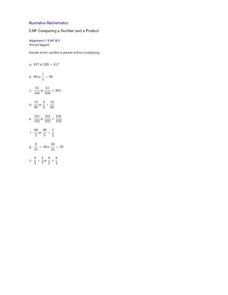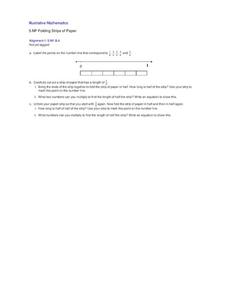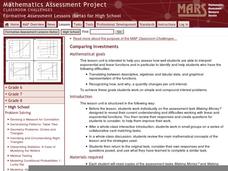Curated OER
Comparing a Number and a Product
Mental math strategies are important for fifth graders to be able to determine the greater sum without actually solving the equations. As a summative assessment, this eight-problem worksheet can give insight into the understanding of the...
Agile Mind
Transforming Graphs of Quadratic Functions
In the activity on this webpage, learners use interactive graphing technology to investigate transformations of graphs. In the first part of the task, they look at the graph of a quadratic function with coordinates of a few points...
Curated OER
Folding strips of paper
Fifth graders need concrete experiences to introduce a unit on multiplying fractions by fractions. A strip of paper is used to create a number line and represent 5/6. It is folded first in half, and then in quarters. After unfolding,...
Curated OER
Comparing Investments
Money, money, money. A complete lesson that makes use of different representations of simple and compound interest, including written scenarios, tables, graphs, and equations to highlight similarities and differences between linear and...
Mathematics Assessment Project
Representing Polynomials
Use this complete and very detailed lesson plan to assess your learners' understanding of two important behaviors of polynomials. The first is the relationship between the zeros of a polynomial function and the function's graph, and the...
Illustrative Mathematics
To Multiply or not to multiply?
When do you multiply a fraction by a fraction? Here, fifth graders are given 10 different word problems and asked to decide if multiplying 2/5 x 1/8 is appropriate. Many times, real-world word problems sound similar although the required...
Illustrative Mathematics
Seeing is Believing
How many visual models can be used to show multiplication? Three basic kinds of models can be used to represent and explain the equation 4 x (9 + 2). The commentary section provides description and graphics to explain the set model,...
Illustrative Mathematics
Converse of the Pythagorean Theorem
Use the given tasks and detailed teacher's commentary to introduce your 8th graders to the Pythagorean theorem and its converse. Embedded links to information about Egyptian geometry make your presentation interesting. Consider giving...
Illustrative Mathematics
Building toward fluency
Here is a great learning task that focuses on the development of areas in computational fluency including strategies in mental math. Young learners are guided through a list of addition expressions that help them visually understand the...
Illustrative Mathematics
Rounding to 50 or 500
In a six-problem learning activity, children are guided to solve word problems that involve rounding to the nearest ten and nearest hundred. A commentary and answer key provide different approaches that learners may take in solving the...
Illustrative Mathematics
Naming the Whole for a Fraction
How many different ways can you represent a whole? In a picture that represents six parts (two of which are shaded), learners are asked to label the parts appropriately to show how three different mathematical interpretations can be...
Illustrative Mathematics
The Stamp Collection
By using language like "half of the stamps," children are exposed to patterns in arithmetic that requires solving a two-step word problem. This type of language opens a new door for transitioning learners toward understanding fractions...
Illustrative Mathematics
Identifying Multiples
Administer an activity that fosters a child's understanding of multiples. Young mathematicians are guided to complete three tasks on a multiplication chart. Once they color the boxes with multiples of two, three, and four, learners...
Illustrative Mathematics
The Locker Game
Here is a learning activity that incorporates a classic puzzle in mathematics. Young mathematicians are guided through a series of statements that describe rounds of pupils opening and closing lockers. The first person opens all 20...
Google
Surveys and Estimating Large Quantities
Looking for an estimation activity a bit more involved than the typical "guess the number of jellybeans in the jar" game? Here, learners use a picture to estimate the number of people at a large event, look for potential problems with...
Howard County Schools
Exit Ticket 3.MD.5
Intended for use as an exit ticket, this worksheet can be used as an extension to a lesson, test, or even homework. Learners complete three tasks that involve finding the area of a figure in square units. Young mathematicians can be...
DK Publishing
Taking 2 Away
Go deep and dive under the sea with subtraction! Kindergartners practice taking two away from different groups of fish and writing in the answer. Have them color the fish for extra fun after they finish their math work.
DK Publishing
Taking 1 Away
Kindergartners who love animals will adore this sweet subtraction activity. They study pictures of birds, frogs, and ladybugs, and count how many are left if they take away one. Once they finish, they can color the animals and display...
DK Publishing
Which Has More?
Reinforce more than and less than with beads, bricks, and bugs. Youngsters will love counting and choosing the picture with more than the other. Numbers 1 - 10 are printed across the bottom of the page so that they can be referred to...
DK Publishing
Taking 5 Away
It's a subtraction party! Kindergartners subtract five balloons, five gifts, and five candles in three illustrated problems. For extra practice, bring in balloons and pop five of them to illustrate subtraction in your classroom.
DK Publishing
Using the 2 Times Table, Part 3
Visualize multiplication with cartoon eyes and ears. Third graders count the pairs of eyes in each box, write the multiplication equation, and solve the problem. The second part of the activity provides space for learners to add their...
DK Publishing
Sneaky Snakes: Missing Numbers
These sneaky snakes can help your kindergartners learn number sequence. Each snake has a number sequence up to 10 between their stripes, and kids write the numbers that are missing from the sequence. Some of the snakes begin at numbers...
DK Publishing
Learning 5 - Write the Number
Fish for fives with a cute counting worksheet! Kindergartners count schools of fish, which all add up to five, and write the correct number in provided spaces. They then copy a domino pattern at the bottom of the page. A great way to...
DK Publishing
Numbers 1 to 20
Practice writing numbers with fun kites. Kindergartners will rise to the highest height as they match the numbers to their correct written forms: 11 to eleven, 14 to fourteen, etc. Use this resource as a class activity or as a review...

























